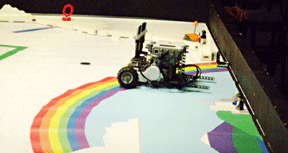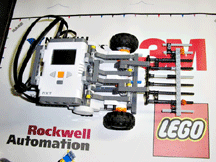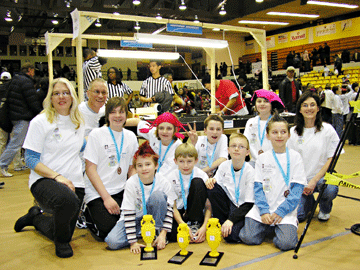
|
Volume XVII, Issue 11 - March 12 - March 18, 2009
|
|
Columns Reviews |
A Boy and His Bot
A new generation of engineers save the Bay, one Lego at a time

by Diana Beechener
Tony Buckley doesn’t play with Legos; he engineers with them.
Buckley, who turns the big one-four March 15, used trial and error, teamwork and Legos to build a robot to combat climate change.
First came the challenge. Competing in The First Lego League — a global organization dedicated to promoting engineering in middle schoolers —13,500 teams worldwide took on climate change.
“We had to take a problem in one part of the world and find a solution for it,” Buckley says.
Then came the team.
Buckley, a Calvert County home-schooler, recruited LEGO LIFE Team 4229’s eight engineers — ranging in age from 11 to 14 — from his home-school co-op. He’s the team’s publicity and fundraising manager.
Next, their robot needed a mission.
The team decided to use mechanics for the good of the Bay, dreaming up a robot that could help nurture the oyster population.
“We are losing oxygen in the Bay because of algae,” Buckley said. Their robot would help plant oyster reefs, putting oysters back in the Bay to filter out the algae.
Now the team needed Legos.
|
|

![]() To compete, teams must purchase a $250 Lego Mindstorm kit and pay a $50 tournament fee. Mindstorms aren’t the primary colored building blocks of yesteryear. The kit is “like a big giant box with wheels, axles, sensors, NXT brick,” Buckley explains. “It’s like the brain of the robot. It also had software for programming.”
To compete, teams must purchase a $250 Lego Mindstorm kit and pay a $50 tournament fee. Mindstorms aren’t the primary colored building blocks of yesteryear. The kit is “like a big giant box with wheels, axles, sensors, NXT brick,” Buckley explains. “It’s like the brain of the robot. It also had software for programming.”
So Buckley learned how to fundraise, selling web-designed T-shirts and caps and calling up newspapers for publicity. He also learned that no one builds the perfect bot on the first try.
“The first robot we built didn’t do as well as we thought,” Buckley said. “We got rid of it and built a new one.”
Beyond basic mechanics and robotics, the team had to perfect its computer programming, making sure the robot could perform all of the First Lego League’s 19 missions. That meant raising flood levels, studying wildlife, testing levees and 16 other tasks — in two minutes and 30 seconds.
“We did trial and error so many times,” says Buckley of programming their robot.
Team 4229’s nameless robot didn’t need to be waterproof to stand up to the Bay; it was a dry-land prototype.
But the team’s idea had to be sound. In Maryland state competition, the middle-schoolers explained the bot’s mission in combating climate change. Their dream of a Bay bot won them second place.
With their ideas set, their mechanics built and their programming saved, the team of rookies entered its second-draft robot into the competition. This bot proved its mettle, earning its creators three yellow-brick Lego trophies.
Team 4229 earned 265 points out of a possible 400, winning first place in the state of Maryland for Robot Performance, second place in Project Presentation and best adult mentor (Dawn Buckley, Tony’s mother and home-school teacher).
Fresh off first-year success, Buckley is looking forward to one more year of wins before his age forces him into retirement.
Buckley and his colleagues in team 4229 are not old enough to get behind the wheel, but they’re engineering a bot to conquer transportation problems for next year’s First Lego League competition.
